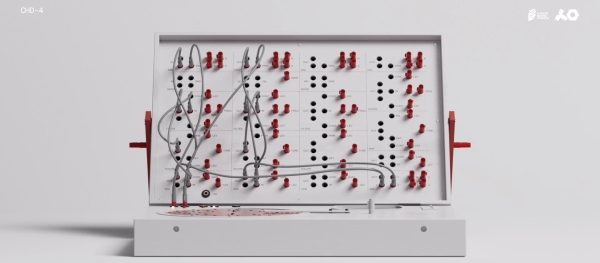When a child is born with congenital heart disease the rhythm of life is disrupted. Despite being the most common birth defect in the world, general awareness of CHD is low. This drum machine was created in a collaboration between audiovisual designer Love Hultén and teenage engineering to highlight the issue. The device, functioning as a modular synthesizer, produces rhythms made using the electrocardiograms of four children with different heart defects.
The different ECGs have been decoded into a sequencer, making it possible to play on the heartbeat of each child. After being introduced to the world on WHOs International World Heart’s Day, September 29, the CHD–4 will continue on tour during the fall to visit different creators and artists.
The machine will be auctioned out on Valentine’s Day 2023 to the highest bidder with all proceeds donated to the Swedish Heartchild Foundation.
A SEQUENCER MADE FROM HEARTBEATS
CHD–4 was created with electrocardiograms from four children with congenital heart disease, printed from real hospital check-ups. Each ECG has been decoded into patterns based on its individual shape, pace, and BPM. These four heartbeat patterns were then transformed into a four-track circular sequencer. When in use, the small rhythm triggers on the sequencer, visible as small dots on each circle, are transformed into audio. Each sequence – or 'heartbeat' – can be played separately or together to produce a wide arrange of sounds.
Each heartbeat can also manually be offset in relation to the other(s) in order to explore different soundscapes and create unique rhythm patterns. The overall tempo can be adjusted via a knob on the front of the machine. For further manipulation, there is also a mute switch for each channel in the upper right corner.
Next to the mute switches is a small OLED screen displaying the audio and beat in real-time, much like an actual ECG machine.
LIV
THIRD-DEGREE ATRIOVENTRICULAR BLOCK
Liv was born in 2017 as one of three triplets. Early on, her parents learned that their unborn children had a risk of developing third-degree atrioventricular block – a condition where the communication between the aria and the ventricles is impaired.
Halfway into the pregnancy, doctors confirmed the worst; one of the babies did. Her parents named her Liv, which means “life”. During her first year, Liv went in and out of hospitals so that doctors could keep her heartbeat under control. Right after her first birthday, Liv received a pacemaker which has kept her heart beating ever since.
JANIYAH
PULMONARY ATRESIA & TRICUSPID VALVE STENOSIS
Janiyah was born with several congenital heart diseases, among them Pulmonary atresia, a malformation of the pulmonary valve, and Tricuspid valve stenosis, a narrowing in the heart’s tricuspid valve. Because of her severe condition, doctors had to step in and support her breathing as soon as she was born – but managed to save her life.
Since then, Janiyah has undergone several heart surgeries and fought for her life a number of times. She even had to celebrate her first birthday in the hospital with her mother and brother by her side. But thanks to specialist care, Janiyah’s heart is still beating, three years later.
VINCENT
TRICUSPID ATRESIA [UNIVENTRICULAR HEART]
Vincent was born with Tricuspid atresia, one of the congenital heart diseases that fall under the collective name univentricular heart. This means that a part of the heart, in Vincent’s case the right ventricle, is as underdeveloped and can’t provide the blood with enough oxygen.
This can cause so-called ventricular extra beats and an irregular heartbeat. Vincent was four weeks old when he had his first heart surgery, which was later followed by two more. Thanks to the medical procedures, his heart is now functioning properly and at age 4, he lives a healthy and happy life with his three siblings.
WEGA
VENTRICULAR SEPTUM DEFECT
Wega was born with a congenital heart disease called ventricular septal defect, VSD. Her tiny heart had a hole between the two ventricles which meant that the heart couldn’t oxygenate the blood properly, which can result in a faster heartbeat.
Doctors discovered the heart defect when Wega was one month old, and she had to undergo several heart surgeries before her first birthday. Today, Wega lives the life of a typical 3-year-old except for routine controls at the hospital.
________________________________________________________________________________________________________________________________________________________
▪ Source: Abby.World|https://www.heartbeatdrummachine.com


